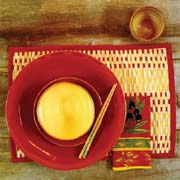

The ritual of dessert punctuates the end of a meal at most Western tables. In Southeast Asia, however, sweets tend to be taken at any time of the day, generally as a snack or for breakfast and, quite often, in liquid form.
Banana, mango, papaya, coconut and coconut milk, as well as glutinous rice, are some of the characteristic ingredients found in Asian sweets. In Thailand, fried bananas are popular—as well as bananas in coconut cream, which also are consumed in Cambodia and Vietnam. The universal urge for comfort food in this part of the world is fulfilled with pudding dishes. Many are prepared with black and/or sticky (white) rice, tapioca, and corn.
Thirst-Quencher Beverages
India and Southeast Asia produce a number of refreshing and delicious beverages often sold by street vendors; however, many are little-known outside their countries of origin. Lassi, India's cooling yogurt mixture, often taken as a liquid snack, can be either sweet or salty, with flavors (i.e., mango or cumin and mint) specific to the region it is made in. Lime water, made from the juice of key limes, also is common, varying from sweet to salty depending on the region.Key lime in Thailand is showcased in its version of limeade, a popular thirst quencher. Though sweet by design, a hint of salt provides the balance of opposing tastes so customary in Asian cooking.
Typical in many tropical climates the world over, fresh fruit juices from guava, mango, pineapple and orange hit the spot. Many are blended into shakes with sweetened condensed milk, fruit, sugar and ice; in Vietnam, avocado often is included. Other traditional drinks in Southeast Asia are sugar cane, palm and young coconut juices.
In Cambodia, jasmine flowers are steeped in water several hours and served with meals. Fresh orange juice sipped by straw right out of the fruit (after kneading), as well as warm lemongrass tea, also delight. Filipinos enjoy Mexican-style chocolate drinks, as this Spanish discovery often is served with mid-afternoon sweet treats.
Coffee in Southeast Asia usually is brewed strong, dark and thick; whether served iced or hot, it often is flavored with sweetened condensed milk. Given these attributes, it becomes a dessert in itself. Well-known by now in the U.S., chai, the heavily spiced and sweetened black (or green) tea mixture from India served cold or hot, comes in both ready-to-drink or concentrate forms.
The dearth of these prepared items may—in good part—be due to their physical composition. Identifying, sourcing and processing consistent-quality ingredients for these oftentimes raw, liquid and/or tropical fruit-based items certainly will provide product formulators with their newest set of challenges in this category.
Interestingly, however, some of these ethnic dessert ingredients have found their way to American diners. Dessert trends, including bananas and coconut, are showing up on diverse menus. PF Chang's (Phoenix) serves a signature banana spring roll: hot wonton-wrapped fried bananas are napped with caramel and vanilla sauces and teamed with coconut-pineapple ice cream. Piña-colada cheesecake in a graham cracker crust, made from several forms of coconut—the cream of, shredded and sweetened, as well as toasted—is the best selling dessert at Houston's Big Island Tropical Grill and Bar, known for its Caribbean- and Hawaiian-influenced dishes.

Tea, the Ancient Brew
As an indubitable part of the Asian culture, tea and its origins go back ages. Though half of all Americans today drink tea, 80% of it is iced, a uniquely American concept. The increasing presence of sweetened ready-to-drink iced tea products has offered convenience while attracting newcomers to try other forms of specialty teas.Green tea, along with specialty teas, is the latest trend, reports the Tea Council of the USA (New York); black teas, though not as popular, have been showing gradual strength. Their tons of good-for-you antioxidants as well as diuretic qualities certainly have fueled their appeal.
Not surprisingly, bottled green tea in Japan surpasses sales of bottled water. Since the 1980s, ITO EN, a leading Japanese supplier of green tea leaves and green tea beverages, has steadily captured the market for these ready-to-drink teas in that country. In 2002, with its first entry in the U.S. market (in N.Y.), the company launched Teas' Teas®, a line of unsweetened oolong and green tea beverage products. Packaged in attractive PET bottles, selections include green, white, jasmine and oolong teas and blends.
The company also introduced Gotta Juice®, a line of 100% juice beverages that blend fruit and vegetable flavors in unique combinations. They have no added sugar and are vitamin enriched. Selections include fruits and dark green vegetables; a varying mix of tomatoes with grapes, apple, lemon and carrots; and garden fruits and vegetables.
Another trend with Asian roots is Bubble Tea, a popular beverage in Taiwanese communities. A frothy iced concoction, usually tea-based with a multitude of other flavors, and served with or without milk or cream, it features large black tapioca pearls made from the bitter-cassava plant. This last ingredient adds an unexpected soft but chewy texture, making it a snack and a drink at the same time. Special straws designed to accommodate these large pearls add fun to the experience. Added flavors range from most tropical and other fruits to taro, lychee, red bean and sesame.
For North American dessert and beverage manufacturers looking for creative new product ideas, India to Southeast Asia should serve as a source of inspiration.
Website Resources:
www.asianonlinerecipes.com/desserts/ delicious_desserts.htmwww.preparedfoods.com/CDA/ArticleArchiveSearch — Type in "Dari Carre"